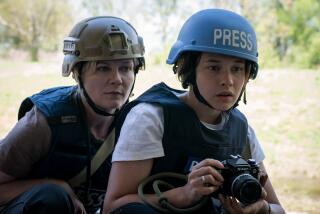BOOK REVIEW : ‘A Woman at War’ in the Persian Gulf: Diary of a Correspondent : A WOMAN AT WAR: Storming Kuwait With the U.S. Marines <i> by Molly Moore</i> ; Scribner’s $22.50, 384 pages
Operation Desert Storm was a war of shocks and novelties: Scuds and Patriots over Riyadh and Tel Aviv, smart bombs and stealth bombers over Iraq and an unlikely alliance of Western democracies, feudal principalities and Islamic monarchies at war with Saddam Hussein.
One of the novelties was the new and sometimes startling role of women on the battlefield: as soldiers, as prisoners of war and as war correspondents. And that’s the hook of Molly Moore’s “A Woman at War,” the battlefield diary of a correspondent who was assigned to cover a ranking field commander during the Gulf War.
“Although several women reporters had covered previous wars from the front lines,” she writes, “I knew of no case in which a female journalist had ever accompanied such a senior commanding general onto the battlefield--much less lived in his tent with him.”
Moore was a reporter for the Washington Post--the first woman to serve as a battlefield correspondent for that newspaper--and she was detailed to follow Marine Corps Gen. Walter E. Boomer as he directed American troops in what Moore calls “the fiercest and most chaotic 100 hours of the Persian Gulf War.”
A good deal of “A Woman at War” is concerned with the logistics of a high-tech war, the Byzantine political machinations that attended the alliance of strange bedfellows in the Persian Gulf and the day-to-day exertions of a war correspondent in the age of laptops and satellite up-links.
We see that old-fashioned wrongheadedness persists in the age of smart bombs, and we are treated to the spectacle of an exasperated Marine Corps officer who pleads for more “dumb green bombs” even though the Pentagon computer models show that he has enough of them already.
Moore recounts her experiences under fire in an urgent “you-are-there” mode, and she makes the most of the colorful details of a shooting war: shellfire, fighter strikes and massed armor attacks, the peril of “friendly fire” from misguided American pilots and tank gunners and the constant anxiety over Iraqi terror weapons.
Moore describes how she marked her Land Rover with orange fluorescent tape to warn off overeager allied aircraft, and she gives us the half-comical moment when she donned a gas mask and plunged to the kitchen floor during an air raid warning.
“If I could smell the stench of tomatoes on the floor and the spoiled chicken parts on the counter above me,” she writes, “I figured chemical particles would have no trouble penetrating my pathetic mask.”
As if to set us up for the remarkable outcome of the Gulf War, she reminds us of the raw fear that plagued the Western forces during the run-up to what turned out to be a lightning victory in the desert.
“The Marines and the Brits had . . . one-seventh of the 1,455 tanks that intelligence photographs indicated the Iraqis had,” she writes, recalling the early days of the buildup. “The Marines were outnumbered two to one in armed personal carriers . . . and were outgunned five to one in artillery cannons. The odds were abysmal.”
Since she was attached to the general’s staff, the most vivid moments in “A Woman at War” focus on the command decisions as they were made in the field by high-ranking officers. At one point, for example, she depicts a Marine general who actually reads the St. Crispin’s Day speech from “Henry V” to his fellow officers: “We few, we happy few, we band of brothers. . . .” And Boomer himself delivers an updated eve-of-battle oration of his own.
“May the spirit of your Marine forefathers ride with you, and may God give you the strength to accomplish your mission,” Boomer intones. “ Semper fi .”
Moore does not miss a chance to point out the momentous quality of the events that she describes (“You are of the select few,” says one Marine Corps officer, “watching history being made.”), nor does she allow us to forget what she regards as the uniqueness of her assignment--a woman in the field with a general.
“How are you doing?” Boomer asks her in passing.
“Well,” Moore responds, “you’re certainly not a dull date.”
She recounts, too, the numerous indignities that a working woman encounters in a fundamentalist society. At the Baskin-Robbins in Saudi Arabia, a sign sternly announces that women are not allowed to eat inside the ice cream parlor. And she was forced to carry a special credential from the American counsel to vouch for the fact that she was pursuing legitimate business: “My female colleagues and I called it the ‘I Am Not a Whore’ letter.”
One of the lessons of the Gulf War is that women are no different than men on the battlefield: They fight, they fall, they die as do any other soldiers. And that’s exactly why “A Woman at War”--with its insistent emphasis on a woman’s perspective--is already something of an antique. When Moore next goes to war, I suspect her memoirs will be gender-neutral.
More to Read
Sign up for our Book Club newsletter
Get the latest news, events and more from the Los Angeles Times Book Club, and help us get L.A. reading and talking.
You may occasionally receive promotional content from the Los Angeles Times.






